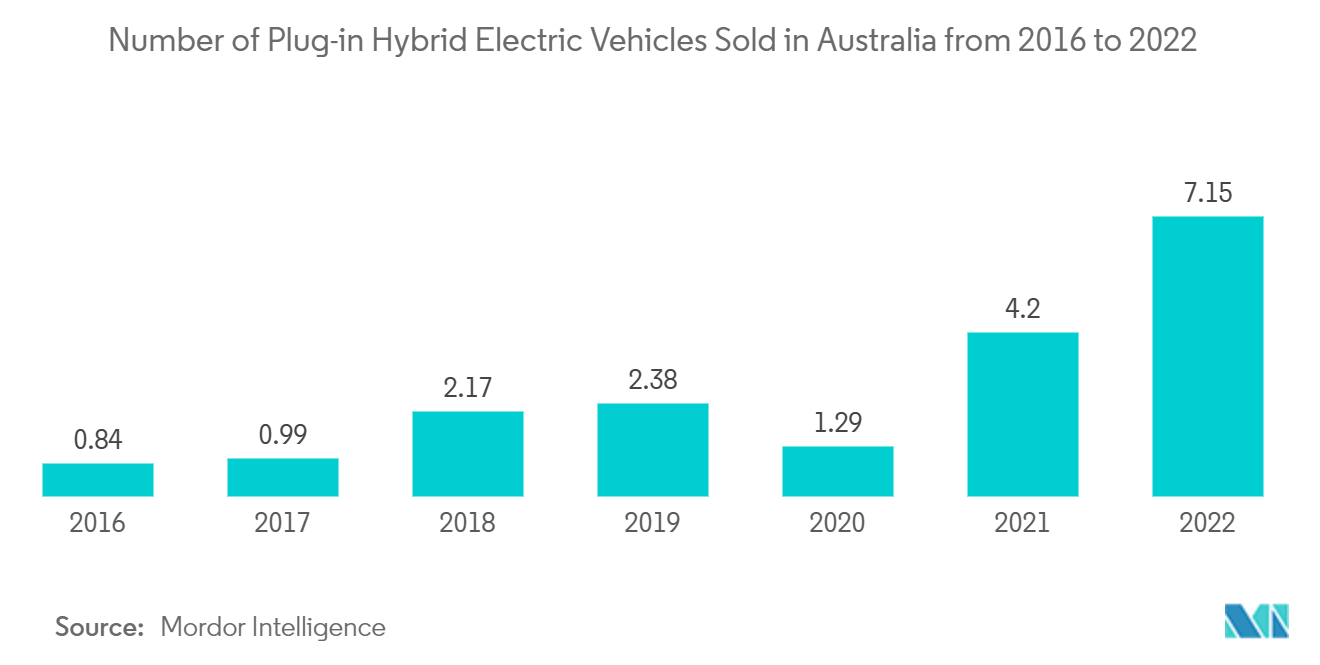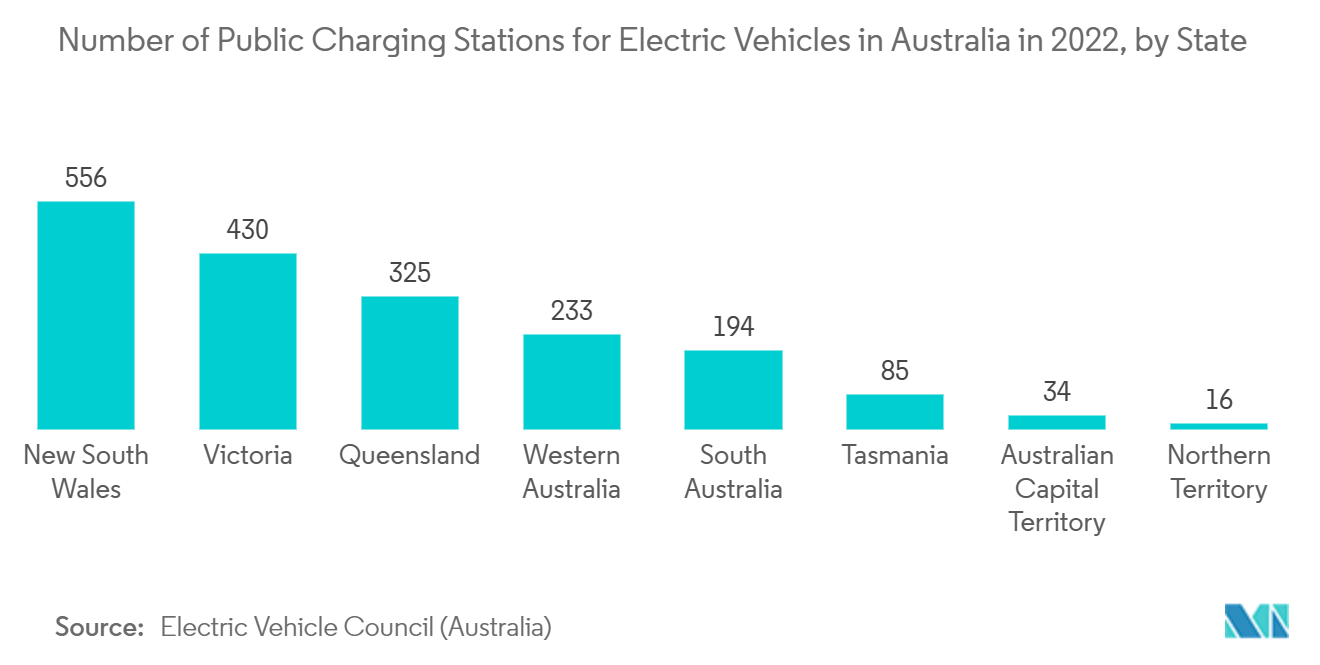Market Trends of Australia Electric Vehicle Industry
Hybrid Electric Vehicle Segment of Market Likely to Hold Significant Share in the Market
- Some of the major factors driving the growth of the market studied are the enactment of stringent emission and fuel economy norms and government incentives for promoting the purchase and adoption of hybrid vehicles. There has been tremendous growth in hybrid vehicles all over the country as these vehicles appeal to a much larger audience when compared to full-electric vehicles. They combine the reliability, long-range drivability, and instant refueling benefits of petrol and diesel vehicles with better fuel economy and a smaller carbon footprint of electric vehicles.
- For instance, in Australia, hybrid automobiles outsold electric vehicles by more than two to one in 2022. With almost 315,000 hybrids sold over the last 20 years, the emissions savings are comparable to putting 95,000 electric vehicles on the road. These cars, sometimes referred to as self-charging hybrids or HEVs, now make up 7% of all new passenger cars, SUVs, pickups, and vans sold in Australia. According to data from the Federal Chamber of Automotive Industries (FCAI), conventional, "self-charging" hybrid vehicles accounted for 89.2 percent of those electrified sales.
- Toyota's lineup of hybrid cars and SUVs accounts for 92.9 percent of those sales. The mid-size RAV4 SUV led the list with 25,850 sales, the Corolla with 14,657 units, and Camry with 10,979 units. In addition, Lexus, a luxury division of Toyota, set records for hybrid sales in 2021, with petrol-electric models making up 38.8% of the 9290 vehicles the company reported as sold.
- This is higher than the growth rates for conventional hybrids and electric vehicles, which were 12% and 127%, respectively. The 41,056 conventional hybrids delivered so far this year outsell the 2,941 plug-in hybrids sold so far. However, with a wide range of vehicles available for sale in Australia across 17 manufacturers and 30 model lines, plug-in hybrid sales are gaining momentum.
- Owing to the growing sales, the portfolio for electric vehicles of key OEMs is expanding, with many consumers preferring to go in for fully hybrid or mild hybrid vehicles across the country. For instance, in July 2022, Nissan announced the new Nissan X-Trail e-Power hybrid model will be available in Australian dealerships in 2023.
- In March 2022, Honda has confirmed plans to launch the next-generation HR-V in Australia. The new model will be available in two trim levels with a choice of petrol or hybrid power, pitting Honda against Toyota's C-HR hybrid and the upcoming Corolla cross hybrid.
- With governments taking stringent actions, in the form of regulations and incentives, along with the increased initiatives for the provision of public charging stations for electric vehicles, the hybrid electric vehicle segment of the market studied is expected to grow at a high rate during the forecast period.

Growing Investments into Developing Charging Infrastructure in the Country
- The growth of electric vehicles (EVs) across the country is mainly supported by supportive charging infrastructure across the country. The massive investments in electric vehicles by major automotive companies, such as Toyota, Honda, Tesla, General Motors, and Ford, coupled with their EV charging strategies, propel demand in the market. The Australian government has been actively funding to improve the EV charging infrastructure across the country.
- For instance, in June 2022, to speed up the electric vehicle (EV) revolution across NSW, the government of New South Wales (NSW) announced an additional AUD 38 million (USD 27.74 million) in charging infrastructure approved as part of the 2022-23 NSW Budget. The extra financing brings the State's EV commitment under the NSW Electric Vehicle Strategy to AUD 633 million (USD 464 million).
- The financing will leverage large private sector investments to meet rising demand. It includes AUD 10 million (USD 7.5 million) to co-fund around 125 medium and large apartment buildings with more than 100 car parking spaces to upgrade their electrical systems to accommodate EV charging and AUD 10 million (USD 7.5 million) to co-fund 500 kerbside charge points to provide on-street charging in residential streets.
- In February 2022, The second round of the Australian government's Future Fuels Fund has begun, and the Australian Renewable Energy Agency (ARENA) will contribute AUD 127.9 million to co-finance charging infrastructure and H2 refueling stations to promote the use of battery and hydrogen vehicles in fleets. Several states have been actively pursuing fast-charging goals by creating strategies that suit their current EVs. Some of the state goals include,
- In May 2022, New South Wales made a significant stride towards becoming Australia's fastest State to purchase and operate an EV with an impressive AUD 131 million (USD 95.63 million) investment. This substantial funding is dedicated to creating the largest charging network in the region. Thanks to the NSW Electric Vehicle Strategy, the State will witness a substantial increase in the number of public fast-charging locations, rated at 50 kW or above, spread across the State.
- Further, in New South Wales, Australia, there were 556 electric car charging stations in 2022. The vast majority of them were conventional charging stations. The number of public electric car charging stations has increased significantly over the previous year thanks to ongoing investment. Various charging infrastructure initiatives have been undertaken by key players in the market to support the growing electric vehicle demand in the country.
- For instance, in April 2023, the Australian federal government announced that it is assisting companies in lowering the upfront expenses of converting to electric cars by allocating USD 6.2 million to a program with Origin Energy that will make 1,000 electric vehicles available to its corporate customers. Origin Energy will supply 1,000 electric cars and charging infrastructure to their corporate clients across Australia as part of the 'Accelerate EV Fleet' campaign. This statement came shortly after the unveiling of Australia's first National Electric Vehicle Strategy and promised to invest USD 70 million in charging infrastructure grant money.
- Such developments and instances are anticipated to contribute significantly to overall demand in the market during the forecast period.

